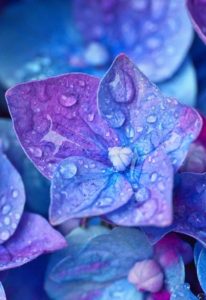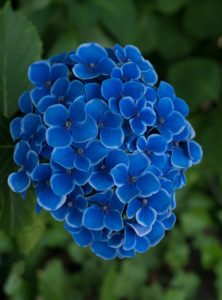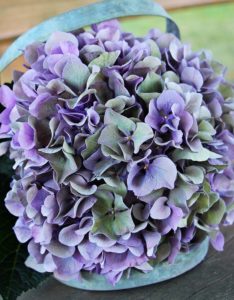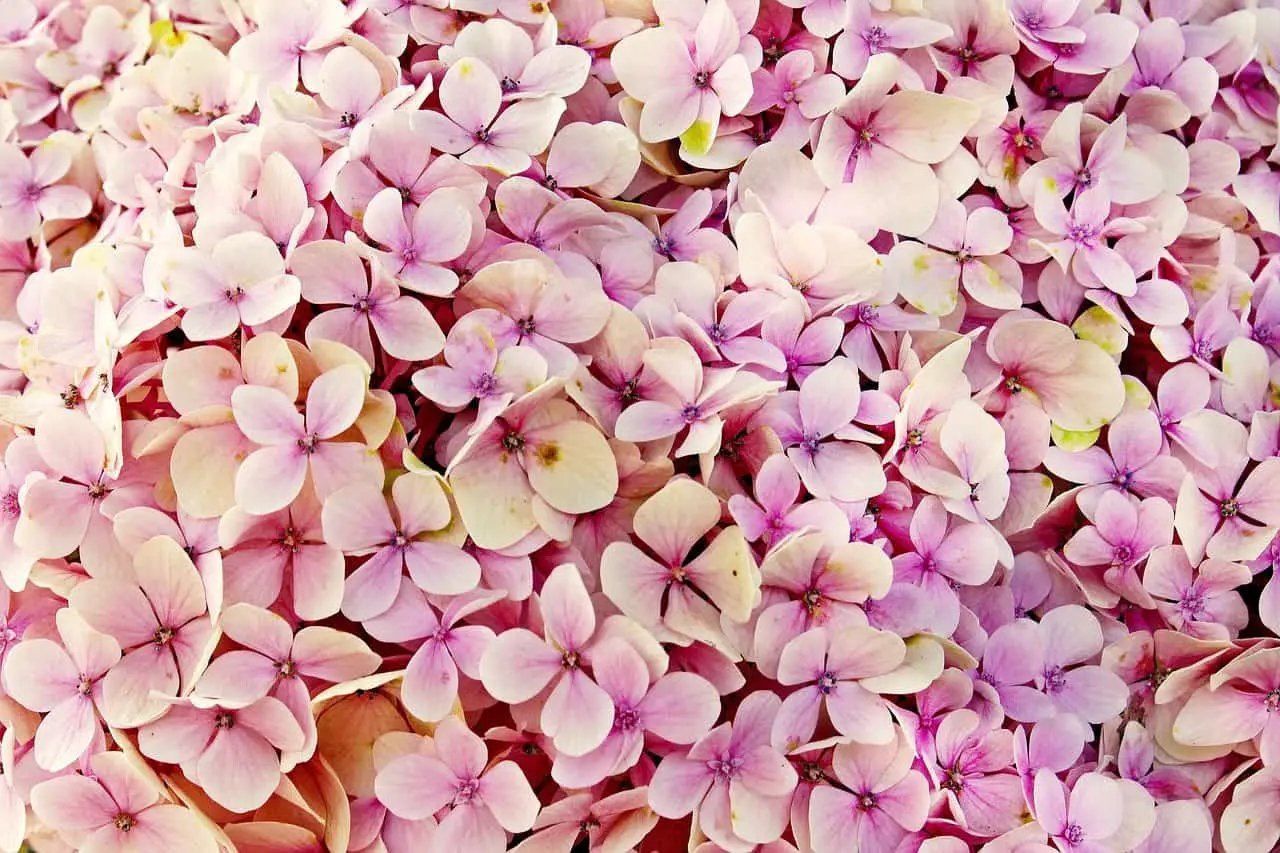Some links in the post are affiliate links and I get a commission from purchases made through some links found in the post.
When I was growing up in South Africa my mom grew these plants.
We called them Christmas Roses and they bloomed in an array of colours, including a magnificent blue which I have always tried to achieve in my own garden in Spain.
The hydrangea is a fairly robust plant which survives and thrives in partial sunlight. There is one variety which tolerates full sun, and we will look at that a little later.
Hydrangeas are classed as low maintenance but there are one or two issues that they have, the main one being leaf scorch.
Leaf scorch on your hydrangea leaves your lovely plant looking less than happy, with leaf tips that turn brown and dry blotches appearing all over.
Wilted leaves are another sign of leaf scorch and you may notice this even before you see a change in the leaves.
Leaf scorch is a non-infectious problem mainly caused by weather conditions. High temperatures, dry winds and dry soil will lead to leaf scorch in your hydrangeas.
Because the leaves of the hydrangea are large, when water evaporates from them they dry out quicker than plants with smaller leaves. They are unable to replace that essential water and prevent damage to the leaves.
How do you Tell That Your Hydrangea has Leaf Scorch?
The first sign of leaf scorch in hydrangeas is that the plant appears to be wilting. The water on the leaves has evaporated and the roots cannot keep up with the demand for more water.
Common reasons for dehydration in your plant is when there has been inadequate watering or exposure to sunlight or reflected light for an extended time.
High temperatures and dry winds will also aggravate the problem.
You will also start to see that the tips on the leaves start to turn brown and this shade starts to run down the middle of the leaf.
The leaves will eventually become crinkly with the brown changing to black, and finally the leaf simply falling off.
Further investigation around the root ball will show you that the soil there is dry.
You will see the first changes in the leaves on the ones that are the furthest away from the roots because this is where the least amount of water reaches.
You may also see damage on the top of the plant and on the sunniest area.
An interesting observation here is that if you are repotting a hydrangea that has leaf scorch you may notice that the mix is very high in peat.
This will cause it to dry out rapidly and almost set hard around the roots.
When you plant in the ground be sure to loosen all the mix around the roots. You may also soak the entire root ball in water before planting in the ground.
What Causes Leaf Scorch in Hydrangeas?
 The main reason for leaf scorch is because extreme weather conditions have meant that any water on the leaves has evaporated.
The main reason for leaf scorch is because extreme weather conditions have meant that any water on the leaves has evaporated.
The roots of the plant do not have enough water to send to the leaves, they become dehydrated and begin to scorch.
Other reasons for leaf scorch are because the plant is placed in the wrong area in the garden or the pot should be repositioned.
Most hydrangeas do not appreciate full sunlight. They prefer partial sun. Neither do they like to be constantly in the wind. A sheltered place suits these plants better.
A few Reasons you May not Know are:
- Water which is too hot coming from a hose which has laid in the direct sunlight
- Incorrect use of garden fertilizer (too strong solution)
- Excessive heat such as would come from heavy machinery close by. Exhaust fumes are also bad for your plant
- Sunburn from being moved from greenhouse to garden and into direct sunlight
- Salt water from hot sea breezes and high winds
- Heat generated from being covered such as with a tarpaulin which heats up in the sunlight.
- Lack of general watering combined with any of the above conditions
Here’s a tip that my dad passed on to me. Being an avid gardener, I know he had his fair share of plants that simply did not survive, though no fault of anything.
With hydrangeas, when in doubt, give the plant a good water to ensure that all the ground around it is wet, and then leave it alone.
All the leaves which are black and burned will offer protection to new growth and leaves under them.
Patience is the key here and cutting off the dead leaves potentially leave new growth open to diseases.
How do we Fix Hydrangea Leaf Scorch?
It is always a good idea to try a non-chemical method as your first choice.
If the reason for the leaf burn is chemically related such as concentrated fertilizer then you may be able to save the plant.
You can do this with a slow trickle of water to help leach away the chemicals in the soil. Do this over a 24-hour period.
Non-chemical Ways to Help your Plant:
- Go gentle on fertilizer to avoid root damage
- Make sure plants which are in sunny or windy spots have enough water
- Consider moving your plant to a better position
- Plant new hydrangeas in a suitable spot. These plants prefer a dappled type of shade, particularly during the heat of the day
- Avoid planting near reflective surfaces such as fences and walls which are in the sun
- Use a good mulch over the root area to keep the soil moist
- In places where the drainage is poor make use of a berm
If moving your hydrangea is not an option then you need to make sure that the water supply is constant and evenly given.
You may also like: How do you get rid of black spots on hydrangea leaves
How can I Prevent Hydrangea Leaf Scorch From Happening Again?
 There are some things that you can do to prevent leaf scorch happening again.
There are some things that you can do to prevent leaf scorch happening again.
Take a serious look at your irrigation method and change it to where the plant is watered often enough.
You may even want to water in the early morning or late afternoon to ensure that the water does not evaporate.
If you water by hand using the hose pipe then make sure that you do not get water splashing on the leaves.
It is also important to keep water off the blooms as they can also become scorched.
A common mistake with these plants is that they are placed in the wrong area of the garden.
We may think that because they grow large, they can be out in the unprotected wind and sunlight – wrong!
They prefer partial shade, and they definitely will not appreciate hot, dry windy conditions.
If you have a hydrangea which you really do not want to move, then consider erecting some sort of shade around it so that it is sheltered from the midday sun.
One thing that you should know about these great plants is that they tolerate being moved very well.
Have no fear if you decide to transplant it to a better position, the plant will survive and thrive there!
There is one variety of hydrangea that will tolerate full sun, namely the panicle hydrangea. This is the hardiest of the species. In fact, they are at their best growing in full sunlight.
Panicle hydrangeas will give you blooms that last for several weeks and start off white, fading to shades of either red or pink before fading to cream.
Even though this variety loves the sun, it will still do well in dappled or partial sun conditions, which makes it a perfect plant for anywhere in your garden.
Why Else may Your Hydrangea Have Brown Leaves?
There is another reason why your hydrangea develops brown spots on the leaves. These can be caused by a fungus or bacteria.
It is important to remember that this is not life threatening to the plant, it simply looks horrible. You will notice them at the end of summer and autumn (fall).
With bacteria or fungus, the leaves will turn a yellow/green and start to fall off. The plant will more than likely survive, even though this happens.
The fungus or bacteria is spread by spores in wet and humid conditions. Be careful when watering your plant that you do not water it from above because this can cause fungus issues.
If your plant suffers from this you should remove and destroy the diseased parts of the plant as soon as possible.
You may also like: Why are my hydrangea leaves curling
Should I cut off Brown Hydrangea Leaves?
If your hydrangea has fungus issues then you should certainly cut off the dead areas. Destroy them so that no other plants are re-infected.
In leaf scorch you should consider the overall condition of the plant.
If it is full of new growth then be selective about which burned leaves you remove as they may be shielding new growth underneath.
While the crispy brown leaves do not look attractive, they are not actually doing your plant any harm, so remove them at your discretion.
Final Thoughts: How to Prevent Leaf Scorch on Your Hydrangea
 These are great plants to have in any garden.
These are great plants to have in any garden.
They are low maintenance once you have found them the ideal spot and they give long-lasting blooms in many colours.
With a little consideration about their placement there is no reason why you should not have a great selection of these plants to liven up your garden.
Before you go, here are some more related articles I encourage you to read below to help solve more of your gardening issues:
Common problems with hydrangeas in pots
Why are my Hydrangeas Turning Green
How to Landscape with Hydrangeas
How Much Water Do Hydrangeas Need
Written by: Valerie Holyoak


